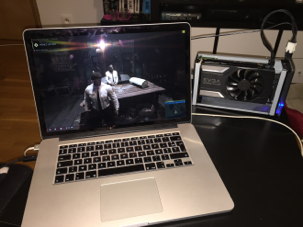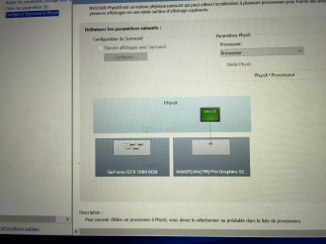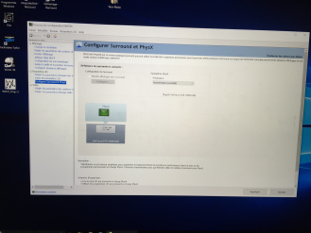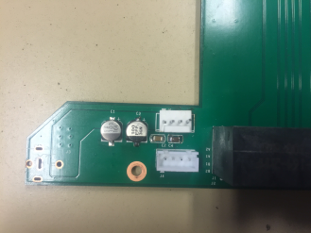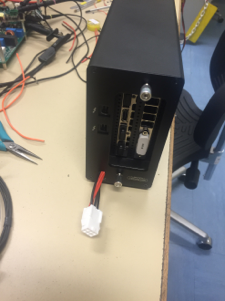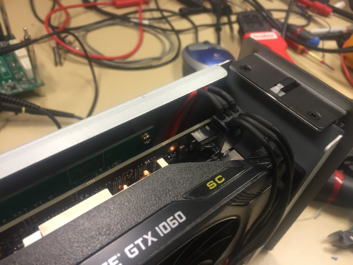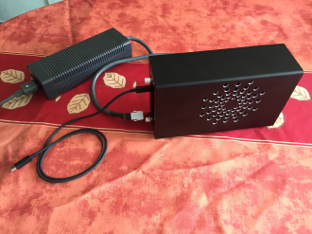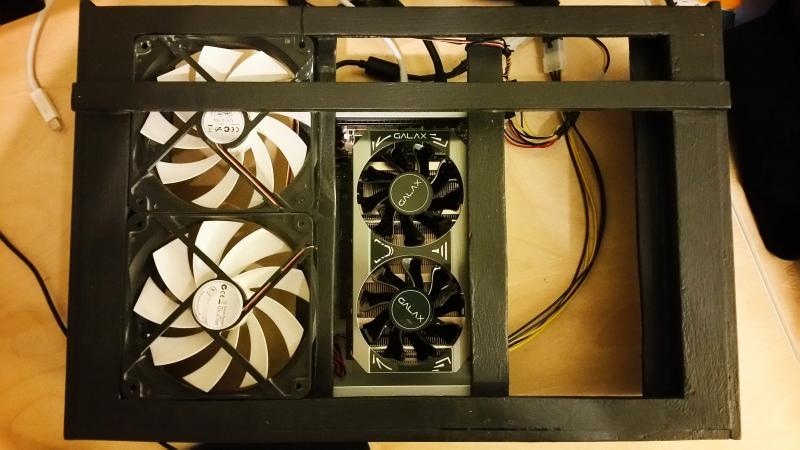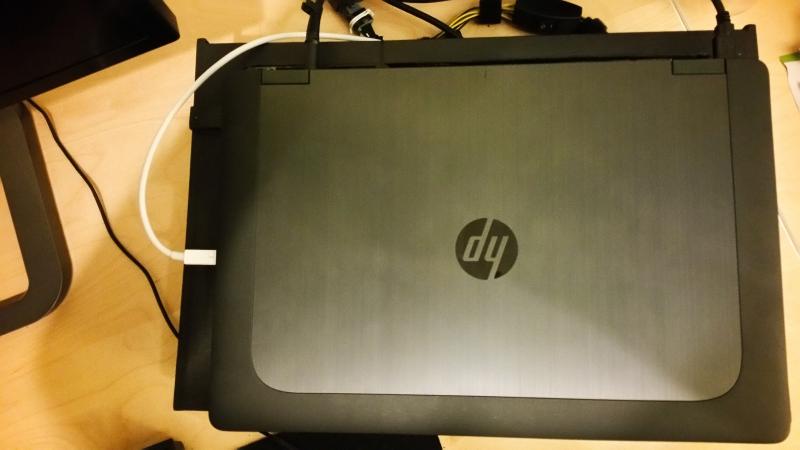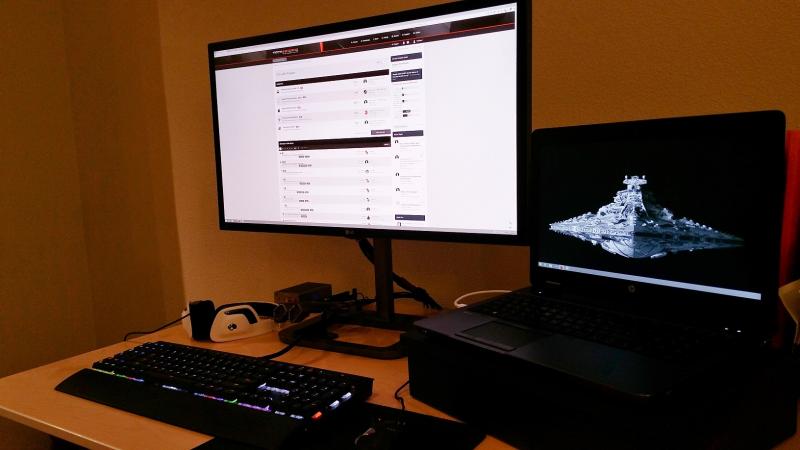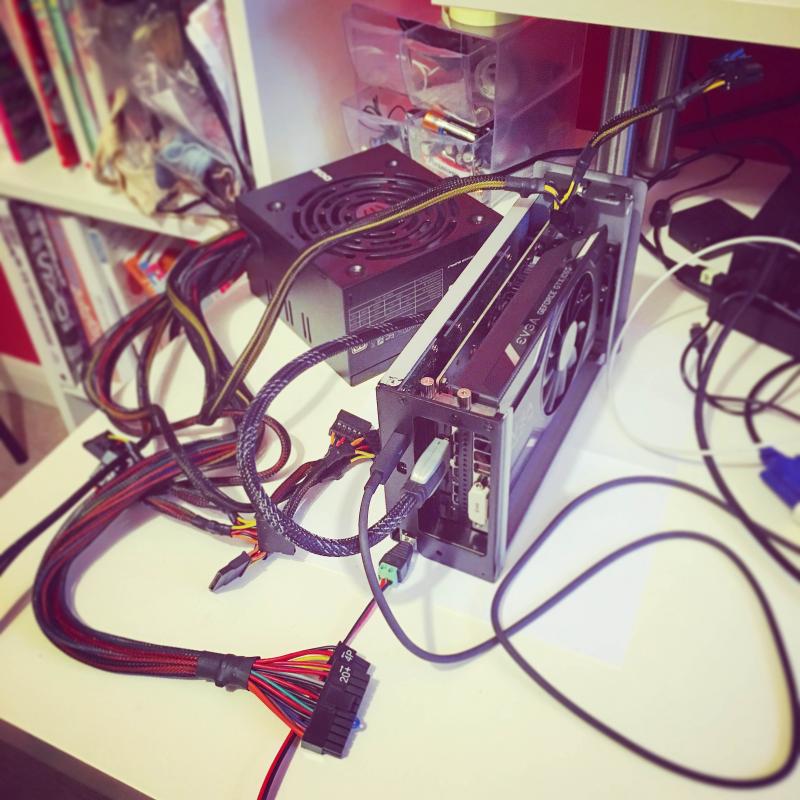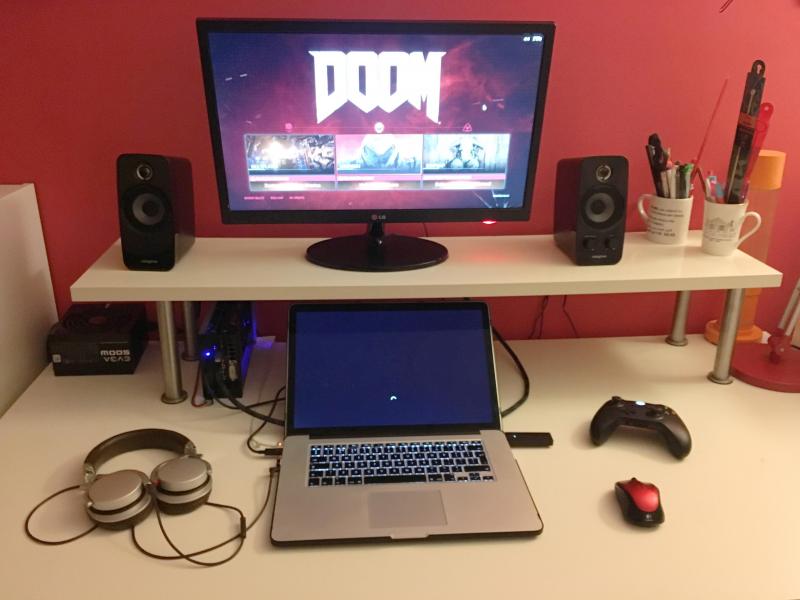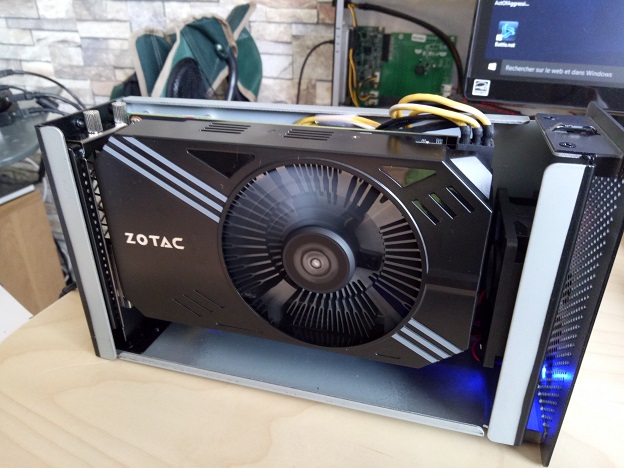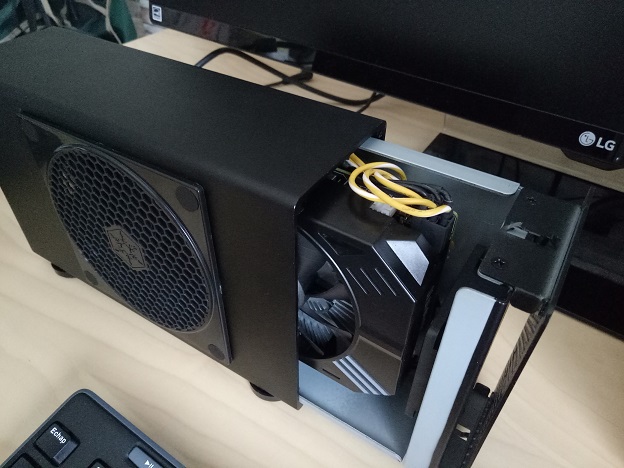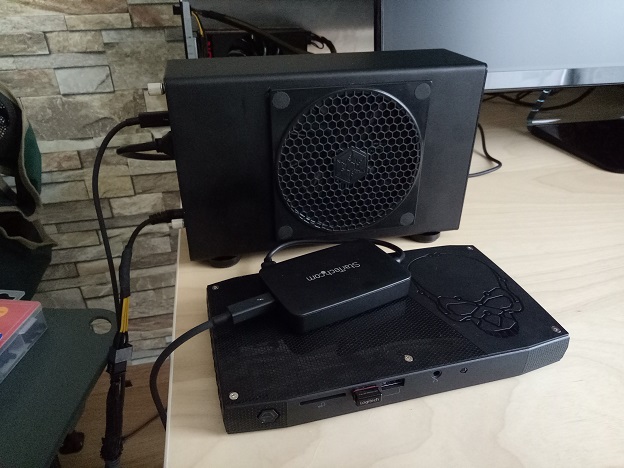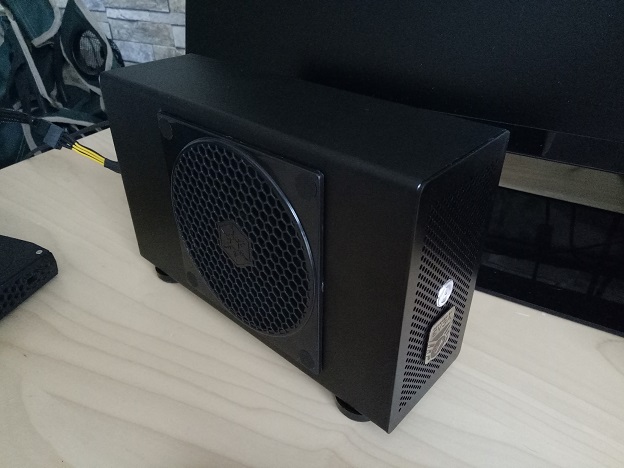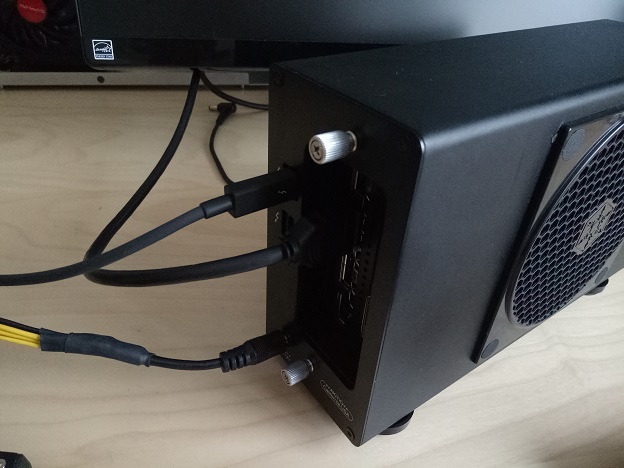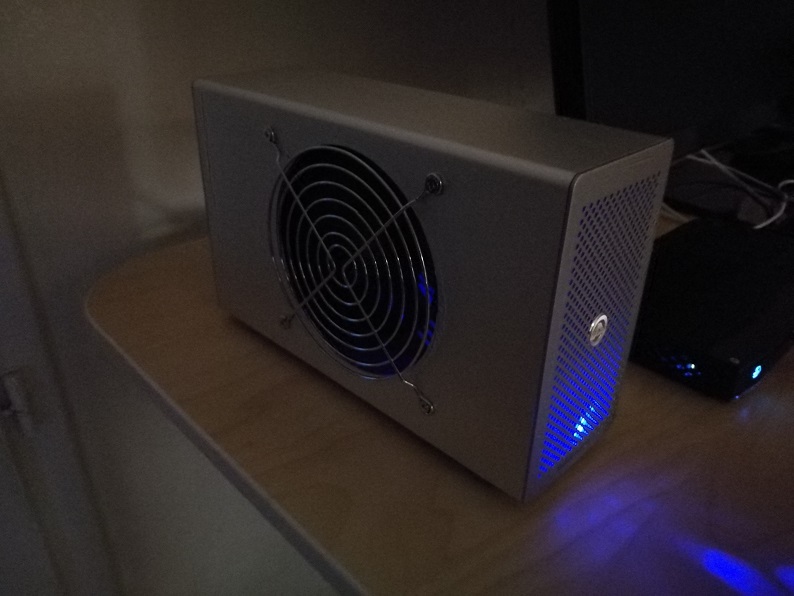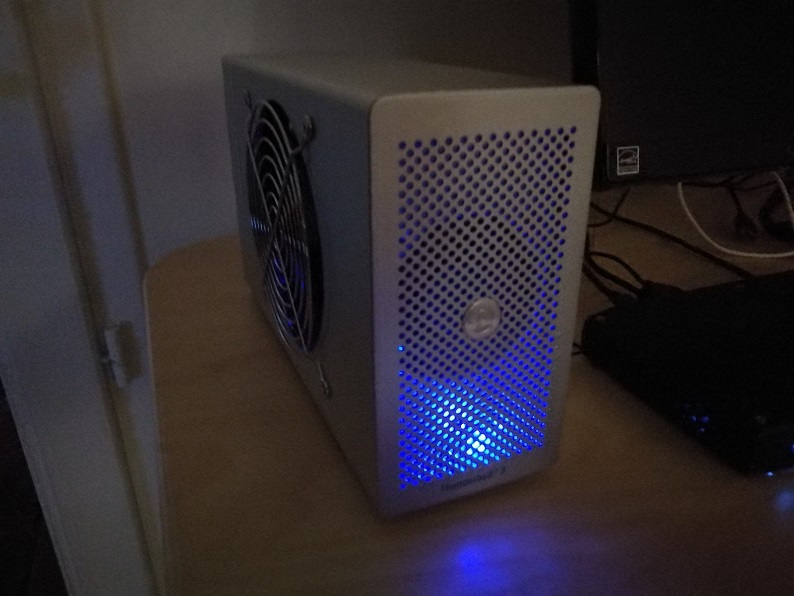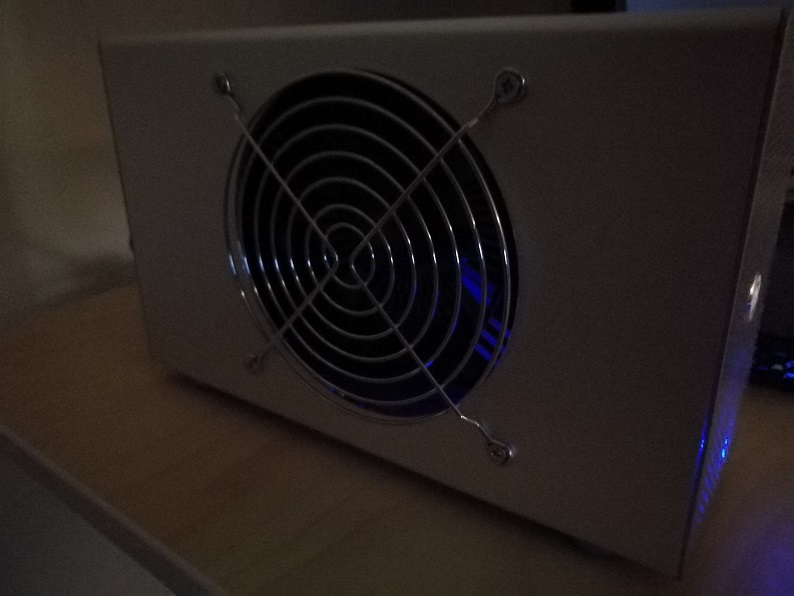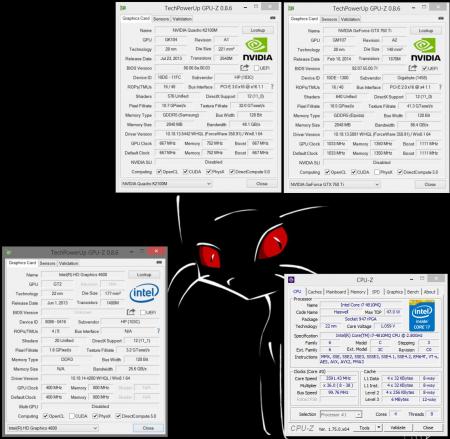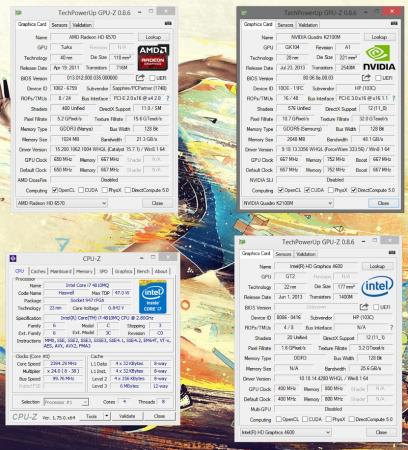Search the Community
Showing results for tags 'thunder2'.
-
Hey guys, Let me introduce you my eGPU setup, realized on a 2013 15" retina Macbook Pro, model equipped with a dedicated GT 750M. I am using an Akitio Thunder2 PCIe enclosure and a EVGA Geforce GTX 1060 SC 6Gb. I wanted to use both internal and external display on my Mac. I was looking for information during weeks before buying it and wasn’t really sure if it would work as I wanted to. Many people are convinced that using the internal screen is impossible or way more complicated if the Mac has a dedicated GPU. I spend a whole week formatting and testing, using UEFI, BIOS, considering going back to Windows 7 (not for long)… I finally used Windows 10 UEFI, the programs rEFInd and GPU-switch and nothing else ! No need for an HDMI headless ghost or any program to spoof the number of screens. I made a video to show you the whole installation process, I hope that it will help: My GF did the voice acting as I wasn't convinced by my own If you prefer a text-based tutorial, here are the different steps: 1) Installation of Windows 10 in UEFI mode On the 2013 retina Macbook Pro, the SSD is a PCIe model. This seems related to the UEFI mode used by default when using the Boot camp assistant. If you don’t want to use it or are using another model of Macbook, you can follow this excellent tutorial to force the UEFI mode: http://fgimian.github.io/blog/2016/03/12/installing-windows-10-on-a-mac-without-bootcamp/ You just need to create a conventional partition and convert your table partition from “hybrid” to “protective”. By doing this, Windows will see a GPT disk instead of MBR. You just need to boot your USB drive on EFI mode. Once Windows is properly installed with the correct Macbook drivers (another reason to prefer the boot camp assistant), you need to go back to Mac OS. 2) Installing rEFInd rEFInd is a boot manager tool, like rEFIt or GRUB. Its first advantage is the ability to choose the OS without the need to press a key at startup. And the real reason why we are using it is to spoof the computer to allow Windows seeing the entire installed hardware. You can install refind from this link: http://www.rodsbooks.com/refind/ Then you need to activate this spoof ability by opening a terminal and typing these two commands: sudo mkdir /Volumes/efi sudo mount -t msdos /dev/disk0s1 /Volumes/efi Now, you can see your EFI partition in your Finder. Go to EFI/EFI/refind and open the file refind.conf with textedit. Search for the “spoof OS version” and remove the comment symbol # Reboot your computer and choose Windows on the rEFInd screen. Open your device manager, you’ll see your iGPU (intel iris pro graphics 5200) and dGPU (Geforce GT 750M) 3) gpu-switch GPU-switch can be downloaded from there: https://github.com/0xbb/gpu-switch Download the windows version, available in the description (direct link : https://github.com/0xbb/gpu-switch/releases/download/v0/gpu-switch-windows.zip ) Install Microsoft C++ redistributable (not sure which version do the trick, I’ve installed each version in x64 and x86 just to be sure) open the file integrated.bat with administrator rights, you should see the word “success” 4) GPU driver installation Not sure if this step is necessary but I’ve removed the dGPU driver before installing nVidia GeForce experience. The program DDU (Display Driver Uninstaller) is perfect for that. You can download it using this link: http://www.guru3d.com/files-details/display-driver-uninstaller-download.html Choose to uninstall and shutdown the computer, as you will install a new hardware indeed When your computer is off, plug the power supply to your eGPU, press the computer power button, wait for the chime and the rEFInd screen to appear, then plug your eGPU to the Macbook and launch Windows. If rEFInd is stucked, hold the power button until the computer is off. You should now see three graphics cards in the device manager, two of them not recognized at this point. Install nVidia GeForce experience and the latest nVidia driver. The GPU list will be updated at the end of the installation process. Re-launch GPU-switch and reboot. You don’t need to unplug the eGPU when rebooting. Now, your eGPU should have an error code 12, with unsufficient resources available. Just right clic on the dGPU (GT 750M) and disable it. Re-launch gpu-switch just to be sure (integrated.bat) and reboot. Just a last step and you’ll good to go Right click on the nVidia icon in your systray and open the configuration panel. Go to PhysX and set it to automatic instead of processor, like on this picture: That’s it, you can now launch your games on the internal screen or using an external monitor To switch between both, just plug the display on the eGPU and use the shortcut Win + P (Cmd + P on a Mac keyboard) to toggle between both screens. You can also duplicate them, it works, but don’t expect any kind of good performances doing this Now, the most important part, to avoid screwing your configuration: every time you go back to Mac OS, Windows will switch to the dedicated GPU (maybe also when turning off the computer, I’m not sure). For this reason, always re-enable the GT 750M before turning off the computer! Otherwise, you’ll get a black screen at Windows startup. Just follow this procedure when you want to use your eGPU: - Use gpu-switch to set the integrated GPU as primary - Disable the dGPU from the device manager - Turn off your computer or reboot - When you see the reEFInd screen, plug your eGPU and launch Windows - Play you favorite video game or launch your intensive GPU application (there are two schools) - Re-enable your dGPU from the device manager - Turn off your computer - Unplug your eGPU Now, some advices based on my little experience: If your end up with a black screen, you can restore Windows to a previous restauration point or remove the display driver. If you really can’t boot windows, using Parallels Desktop, you can boot your Windows partition from a virtual machine, then remove the display driver. At first, I was experiencing a game crash and the GPU fan running at max speed, when launching any sort of game. This issue was caused by the power supply connection, using an Xbox 360 S adapter with too thin wires These wires caused a voltage drop when consuming the 100W needed when playing a game (against 15W on Windows) About the electrical connections, here are a few pictures I’ve added a connector on the free PCB footprint to avoid soldering wires on the board. The cables are 0,75mm2 section and fits perfectly the original jack hole. About the PCIe power connector at the top of the graphic card, I had to cut it with a Dremel to fit the enclosure. You can find specific (and pretty expensive) cables on Ebay if you don’t want to modify one. For the ventilation, a colleague helped me cutting holes in front of the fan. I’m not sure to keep this solution, as some games make it very noisy. Let me know if this tutorial or the video did help you. Don't hesitate to ask for support if you want to do the same setup. Some websites are pretty discouraging about the concept of eGPU, the whole process is not pretty user-friendly but I'm happy to see that there is an active community growing each year !
- 3 replies
-
- 2013
- retina macbook pro
-
(and 7 more)
Tagged with:
-
Hi all, I've recently purchased a thunder2 enclosure and I'm planning to use it with a MacBook under OS X 10.10.5. I would use mainly for speeding up the stitching of a GoPro 360 rig as the internal GPU is really slow and makes the rendering a real nightmare. I'm here to ask you some guidelines about the gpu and, if needed, the psu. I'm looking for the most stable solution with lower power consumption and short size. would be a rx460 a good solution? Does it works well under OS X? Do I need a psu or a specific power supply ? Thanks!
-
- os x 10.10
- thunder2
-
(and 1 more)
Tagged with:
-
I want to know if i can using external gpu RX 480 GPU with windows laptop ASUS G751JT that have dgpu i need to using interal gpu in my linux arch and second gpu to using with windows 10 please i need answers
-
Hi, I was wondering if anyone has run into the same problem I am having. A fully functional eGPU setup on my NUC has started displaying the following issue following a failed Win10 update that caused the system to hang (it wasn't a driver update): 1) The system boots up perfectly without the eGPU and the TV gets a signal from the HDMI. 2) If the Akitio is connected, then the BIOS/POST appears on the HDMI output of the NUC, but the second windows loads, then both HDMI outputs (NUC's iGPU and the GTX750Ti) go black and the system hangs. 3) If the Akitio is connected to a running system, the GTX750Ti is detected in the device manager and appears as functional (no code 10/12/43), but then windows begins to stutter and locks up hard after 20-30 seconds. The display output from the NUC itself freezes, while the display output from the GTX750Ti is black. I have tried to salvage the system by reverting to a restore point, but that did not help. I reinstalled windows, but the new installation displays the same issue. I am somewhat perplexed, because this came out of the blue and screwed up my HTPC without any clear cause. I am wondering if using Setup 1.30 would help here somehow (perhaps by actively disabling the iGPU)? I am willing to wire the 25$ to Tech Inferno Fan for it (I did not need it before). Has anyone else run into Thunderbolt eGPU black-screens of this sort? Thanks! -Y.
-
Hello all, I am new to this forum so I apologize in advance if this question is in the wrong place or has already answered elsewhere. I am thinking about setting up my 13 inch mid 2012 non-retina MacBook Pro with an eGPU. I considering an EVGA GeForce GTX 1060, similar to this one: http://www.newegg.com/Product/Product.aspx?Item=N82E16814487267 I am also considering an AKiTiO Thunder2 PCIe box since it is not too expensive: http://a.co/7TsdwNH I know I will need an power supply of some sort as well but am not sure what I want to get yet since I am new to all of this (any suggestions are welcome). So, my main question is, with the GTX 1060 fit in the Thunder2 box without modification? I also request that if anyone knows of a cheaper thunderbolt 2 box out there please let me know. I would like to set up this GPU as cost effectively as possible. Thank you in advance for your help!
-
This is essentially an upgrade of my previous setup from a Gigabyte GTX750Ti 2GB to a Galax GTX960 4GB that was available on clearance for 94$ about a week ago. The Galax GTX960 Mini (but not the EXOC) fits inside the Akitio if you remove the front fan, which in my case is immaterial because I am using the enclosure open, on its side, and using it as a base for my homebuilt laptop cooling pad so that fan was blocked anyway. It takes a single 6-pin power plug which meant that I needed to replace my 180W barrel-plug power supply with something that could feed an extra power connector. The power solution is the ubiquitous 220W Dell DA-2 for 10$ off ebay: I split the connector with a 6-pin PCIe splitter and then soldered a power switch between the sense contact and one of the grounds. That lets me power it up and down easily and avoids paperclips. One of the 6-pin connectors goes into the PCIe 6-pin power on the video card, while the other was split into a 4-pin ATX plug (like the ones used for CPU power on a desktop motherboard) and a regular molex connector that has an independent power switch. The molex is used to power up the fans in the cooling pad (hence the separate power switch for when that is not needed) while the 4-pin connector powers the barrel plug (which has a 4-pin female connector to match). Laptop: HP ZBook 15 G2 Core i7 4810MQ 16 GB DDR3 1600Mhz RAM Intel Pro 2500 480GB SSD nVidia Quadro K2100M 2GB GDDR5 dGPU (Note: The iGPU is disabled in the BIOS) Windows 8.1 Enterprise 64-bit eGPU and External Monitor (I do not run the eGPU with output on the internal screen): Galax GTX960 OC Mini 4GB Dell DA-2 220W PSU Akitio Thunder 2 0.5m Apple Thunderbolt cable LG 31MU97-B (4096x2160) monitor connected to the eGPU via Displayport Setup: As stated in my previous build: This is my work laptop. As a result, I cannot fiddle with boot loaders, replace operating systems and in general I am under the constraints of the whims of the IT department. I suspect that Win10 would be a lot easier to work with here, but alas I cannot upgrade past 8.1, at least for now. This results in the following procedure to get this working once I get home from work. Note that I have the iGPU disabled in the BIOS, as it was giving me some trouble. It is a lot easier to work with just the nVidia driver, as opposed to both the Intel one and the nVidia one. If the laptop is powered off: 1) Connect the Akitio's Thunderbolt cable to the laptop. 2) Power up the Akitio via the DA-2's power switch that I added. 3) Boot up the laptop and log into windows. 4) Either the eGPU will work, or it won't be recognized, or it will be recognized but the external monitor connected to it won't be detected, or it will Code 12. i) If it works: All is great. Enjoy! ii) If it is not recognized: Reboot the laptop, it will work after the reboot. iii) If it is recognized, but the external monitor is not detected: Reboot the laptop, it will work after the reboot. iv) If you get a code 12, then open up the Device Manager, right-click the eGPU and choose "Disable". Then right-click it again and choose "Enable". Windows will prompt you for a reboot and everything will work perfectly after the reboot. If the laptop is on: 1) Power up the Akitio. 2) Connect the Thunderbolt cable to the laptop. 3) Either the eGPU will work, or it will Code 12. 4) If it works, great. If it Code 12s, do the disable-enable trick I described in the "If the laptop is powered off" step 4.iv and reboot. I did not run into Code 43s or any other issues. Removing the eGPU while the laptop is powered up is possible if you disable it in the Device Manager first (since I don't have Windows 10, I don't have the neat nVidia tool to do it directly). Removing the eGPU cable without disabling the device first will lead to an immediate BSoD. The image below shows a view from the top of my cooling pad with the open Akitio at its base. The two fans on the left blow up into the laptop's cooler intakes. The Akitio's floor serves to separate them from the downward airflow from the video card's fans. You can see some of the cabling, but there is a better photograph of the cables in the next post. This is the laptop on top of the cooling pad. The screen is closed and you can see the three cables I need to connect to get all my peripherals working once docked: The Thunderbolt cable (white), the laptop's charger at the top left and the USB3.0 cable leading to the USB3.0 hub in the monitor at the top right. I apologize for the poor lighting, but here you can see the whole setup. The K2100M runs the laptop's internal display, while the GTX960 runs the external one. The laptop sits on top of the cooling pad/eGPU assembly.
-
This is probably the simplest eGPU setup I've dealt with so far. It is also rather silly, since the CPU is definitely the weakest link here. An Ivy Bridge i3 at 1.8Ghz isn't going to push high frame-rates in gaming, after all, and the performance improvement definitely doesn't justify the cost. An actual use for something like this would be to add HEVC decoding abilities to an existing NUC. Just use a cheaper enclosure (such as the 140$ Thundertek one) or opt for mPCIe instead of Thunderbolt to keep the price as low as possible. Obviously the GTX750Ti I used here doesn't decode HEVC in HW, but I suspect a newer low-range video card will work just the same and will do so. I guess I just had to try it. Anyway: Computer Components: Motherboard: Intel DC33217CK (CPU: i3 3217U @ 1.8Ghz) Case: Silverstone PT14 Aluminum NUC Case Memory: 2x4Gb DDR3 1600Mhz Storage: BP4e V2 120GB mSATA SSD Power Supply: FSP 65W NUC PSU OS: Windows 10 64-bit (with the Anniversary Update installed and completely up to date) eGPU Components: eGPU Enclosure: Akitio Thunder2 eGPU Power Supply: 180W Dell Adapter (this is the one that came with my PE4C ages ago) eGPU: Gigabyte Low-Profile OC GTX750Ti (60W TDP BIOS Mod) eGPU Thunderbolt Cable: 0.5m Apple TB Cable This is a truly "this just works" setup: Plug everything together with the NUC powered off, boot into windows, wait for the drivers to get installed, reboot if required, switch monitor output to the eGPU, done. Note: The card is reporting an x4 2.0 PCIe link - This is incorrect (the DC33217CK only has a Thunderbolt 1 controller) and CUDA-Z confirms the transfer rate to be about half of what my Thunderbolt2 ZBook gets. This means that GPU-Z is not a reliable indicator of the actual PCIe link established.
-
THANKS TO ENCOURAGING GUIDES ON THIS SITE, I HAVE MANAGED TO GET MY EGPU SETUP WORKING Macbook Pro Retina 15” Mid 2015 AMD Radeon R9 M370X 2048 MB 2.8 GHz i7, 16GB RAM Windows 10 64bit ( bootcamp ) OSX Sierra Enclosure: AKiTiO Thunder2 Graphics card: EVGA NVIDIA GeForce GTX 1060 6 GB GDDR5 Memory PCI Express 3 Graphics Card Power supply: EVGA 100-W1-0500-KR - 500W 80 Plus Power Supply (100-W1-0500-KR) Connections: Molex to barrel adapter to connect PSU to GPU and enclosure GPU powered by the PSU directly HDMI cable to connect GPU to monitor Thunderbolt cable to connect Thunder2 to Macbook PSU powered on using the 'paper clip technique' Monitor: Dell U2715H 27-Inch Widescreen IPS LED Monitor Info and guides: https://www.techinferno.com/index.php?/forums/topic/7947-the-basic-egpu-hardware-guide-for-macs/#comment-118751 Process: Power on and connect the GPU, check that the Nvidia is showing up in the device manager Install Nvidia drivers Disable discrete AMD GPU in the device manager and shut down Boot back up into Windows10 and BOOM, Windows10 should now be using the GPU. Results: I can reliably get the eGPU to work every time and have experienced NO CRASHES! I still play games using the AMD when I'm not at my desk, which just requires re-enabling the AMD. Sometimes switching the AMD on and off can cause the device manager to hang, but restarting Windows 10 sorts this out so I've not had any problems using the system both ways. Games Performance: Doom - 1440p max settings - 60pfs ( WOW!!! ) Deus Ex Mankind Divided - 1440p max settings - 30-45 fps Just Cause 3 - 1440p max settings - 30-45 fps Star Wars Battlefront - 1440p max settings - 30-45 fps Overwatch - 1440p max settings - 60fps Getting Windows10 to select the eGPU as the primary display device: As far as I can tell, all that is required to get the GPU to power the external display is to disable the discrete graphics chip (AMD R9 M370X) via the device manager in Windows10. In my experience, provided the eGPU is connected, disabling the AMD R9 will automatically cause the OS to switch to the eGPU. Although a couple of times when I've done this without restarting, the AMD has switched itself back on! Provided the eGPU is connected and powered on, and the AMD is disabled, booting into Windows 10 will automatically select the eGPU and you're away!
-
Here is my first attempt of doing building an e-GPU. What I wanted to do : Due to the fact that having a Razer Core is a pain in the *** and because it's a 7Kg not so portable solution, I decided to build myself my own e-GPU using an Akitio Thunder2 casing for the latest Intel NUC6i7KYK “Skull Canyon”. I also wanted not to change the power connector of the casing. Costs : Akitio Thunder2 : 211.45€ Thunderbolt3 to Thunderbolt2/1 adapter : 95.19€ Dell DA-2 Power Supply : 27€ ZOTAC GTX 1060 6GB : 320€ (174mm x 111.15mm) The Plan : The steps : 1\ Cut the DELL DA-2 cable properly to expose the 8 wires. 2\ Solder all GROUND together as well as all 12V together. 3\ Solder the 2 obtained wires to a 5.5x2.1mm barrel. 4\ Solder two thick wire from the barrel to the top back of the casing (15cm). 5\ Split the two wires into a 6 PIN MOLEX connector. 6\ Cut a 110mm hole inside the casing. 7\ Fix a fan/dust protection. How it works : Great ! Not so much test so far but pretty stable playing the latest DOOM. 2560x1080, HIGH settings with V-SYNC ON :60fps 2560x1080, HIGH settings with V-SYNC OFF : 90fps Next steps : Figure out if there is a difference in performance using the Akitio TB3 prototype. Photos (new model: Akitio Thunder3): Photos (old model: Akitio Thunder2):
-
Ok so I do I lot of work on Rhino 3D, Sketchup and too Revit. I also use Maxwell and sometimes VRay for rendering. My current 15" Macbook pro with Iris pro graphics really sucks for this. When I move models around they get laggy and often freeze and crash. I do expect rendering to always take a while. Should I go with the Thunder2 and a GTX 970 with a PSU or would I be fine with the built in AMD R9 m370X of the higher priced macbook. The GTX kills it on benchmarks however the GTX requires a PSU and its hard to take around.... Thanks!
-
A couple of months ago, I have received a ZBook 15 G2 from work. This laptop comes with a Thunderbolt2 port, and my six-year old desktop was getting a bit long in the tooth, so I decided to ditch it altogether (as the laptop was better by every single parameter except the video card). After browsing the excellent guides and information repository here on the site I have decided to go for my second eGPU build (the first was a Lenovo X230 running a HD7950 via an Expresscard slot). This is a summary of my experience. What makes it a little different from other, similar, builds is that I am constrained by an Enterprise operating system and I cannot tweak my system to the extent that most home users are able to (I cannot reinstall the OS, I cannot hack the BIOS, I cannot add special bootloaders and so on). Software: Windows 8.1 64-bit Enterprise installed on a GPT (UEFI) partition (No BIOS mods or any bootloaders added, as this is an enterprise managed system and I cannot do these things). Hardware: Laptop: HP ZBook 15 G2 CPU: Intel Core i7 4810MQ iGPU: Intel HD4600 dGPU: nVidia Quadro K2100M (2Gb GDDR5) RAM: 2x8Gb DDR3 1600Mhz SSD: Intel Pro 2500 480Gb (Disk encryption enabled) External Monitor: Samsung 2333T (via HDMI to DVI cable) eGPU Enclosure: AKiTiO Thunder2 eGPUs Tested: Sapphire HD6570 (1Gb GDDR3) [Initial Testing] Gigabyte Low Profile GTX750Ti (2Gb GDDR5) [Final Setup] Setup Choice Thought Process: 1) I have opted to not modify the Thunder2 enclosure in order to not void my warranty. This constrained me to sub-75W video cards. As a result I chose the GeForce GTX750Ti as the best candidate. I picked the low-profile Gigabyte because it was the cheapest GTX750Ti available locally (go figure). 2) The 60W adapter included with the Thunder2 would not be sufficient to power my video card at full load, so I would need an improved power delivery method. 3) I wanted a compact, aesthetic, mobile, plug and play setup (or at least as plug and play as possible). This meant that running an open enclosure or an ATX PSU was not an option. 4) Thankfully, I found out that the Thunder2 can accommodate a 75W card if it is provided with a better power-brick (source) and I also realized that the Dell-branded power-brick from my previous Expresscard setup (on my previous Lenovo X230 work laptop) has the same barrel plug and the same output voltage, but with a higher wattage. Installation Instructions: 1) Install the video card into the Thunder2 enclosure and connect the enclosure to its power source. 2) Power off the laptop. 3) Connect the external monitor to the eGPU's video outputs. 4) Connect the Thunder2 to the laptop via the Thunderbolt2 cable. 5) Power up the laptop and boot to windows. Note: During the initial setup, windows detected and installed the eGPU drivers automatically. 6) Either the eGPU is immediately functional, or the driver will fail to load with a Code 12. 7) In the case of a Code 12, disable the eGPU in the device manager, enable it again and reboot the system when prompted by windows. 8) When the system boots up again, the eGPU will be fully functional, as will be the iGPU and dGPU. Note 1: The Code 12 mentioned above only happens (and not always) once per docking. If the laptop shuts down (or reboots) with the eGPU connected and is powered up again with the eGPU still connected, then the Code 12 issue will never occur. It will only appear occasionally on the first docked boot after the laptop was used without the eGPU attached. The above mentioned solution works without fail, however. Note 2: Note that I only connect/disconnect the eGPU only when the laptop is off since this satisfies my use cases - I did not yet try "true" plug and play. Since I use the laptop docked at home and without the eGPU on the road and I do not hibernate (or sleep) my machine, I never ran into the case where I needed to connect or disconnect the eGPU with the machine powered up. Note 3: I prefer to use an external monitor as my main one so I have no need to run the internal monitor off the eGPU and I did not try to get this to work. Note 4: When booting without the eGPU for the first time after disconnecting the dock, sometimes the laptop would do a double POST (the HP logo would appear, disappear, then reappear, then the windows boot will commence). This has no ill effect (other than adding a couple of seconds to the boot time). Consequent boots without the eGPU are not affected (until you dock and undock again at some later point in time). Note 5: Dynamic PCIe link speed is working. So when the eGPU is under low load, it will drop its PCIe link speed to x4 1.1 instead of x4 2.0. You will see this happen in the attached GPU-Z screenshot. It ramps up back to x4 2.0 when the eGPU is loaded. Note 6: I did not perform synthetic benchmarking at this time. I did confirm the eGPU works, however: I played Borderlands and Cities: Skylines at max graphical settings at 1080p and tracked eGPU clock rates, PCIe link speed and eGPU load and memory use. All seems to be in order and the eGPU is being properly utilized. Note 7: I was able to direct all PhysX processing to the dGPU K2100M in the nVidia control panel. Not that I really play anything with PhysX enabled, but the option was available. See next post. Note 8: The fan in the Thunder2 is incredibly annoying. It is noisy as hell and is audible even at a reasonable distance. Since the GTX750Ti is a very cool running card, I have tried removing the fan from the enclosure. The setup is much quieter, but the temps rise under prolonged loads, reaching a top of 81C. It isn't horrible, but that would kill pretty much any OC room I might have, so I have reinstalled the enclosure fan. Note 9: Another way to get rid of the Code 12 issue on docking is to power up without the Thunderbolt cable connected, stop the laptop's boot at the BIOS menu (hitting ESC on boot), connect the Thunderbolt cable, then choose the boot drive. When booting to Windows the eGPU is properly accommodated and the Code 12 does not appear.
-
Hey Guys, i've got bit of a problem with my current eGPU Setup. I followed some of the excellent guides and wanted to do a small but powerful setup. My Aikito Thunder 2 is only powered by a 150Watt Leicke AC Adapter but i think the gtx 970 also needs power supply maybe thats the error here. When i'm booting with everything plugged in i get an "ACPI_BOOT_ERROR" from windows if i hot plug everything i get this little warning sign in the devices manager with an error 43, maybe cause the graphic card don't get enough power. I also ordered the Dell DA-2 from amazon and it's coming tomorrow but what i'm missing is this 6 to 8 pin to dc barrel plug adapter which i cant find online and i have no expertise in building cables Maybe if someone of you guys knows how to build something like this i would be very thankful and of course paying you something for this. Hope you can help me thanks in advance Here is the current setup: Here is the error: and here is the cable i need but i dont know how to build or where to buy:
-
Hi, I've not posted on here since I built my eGPU for my 2015 MacBook Pro over a year ago. That unit was an Akitio Thunder2, RM 650W PSU, CoolerMaster 130 case, powered riser cable with a Zotac GTX 770 card. It's mainly used for playing Elite Dangerous on and it has been working perfectly. Recently I had the opportunity to upgrade the GTX 770 to a GTX 980 Reference card. It was pretty much a straight swap out except for the cards power connectors. On the GTX 770 these were 1 x 8-pin and 1 x 6-pin connectors. On the GTX 980 these are 2 x 6-pin connectors. Simple enough with my 650W PSU I just switched connectors. I am using the same powered riser cable for the PCIe connection. The unit boots up and works okay on Windows 10 via the display port connection. It will even play Elite Dangerous on Ultra settings and give a steady 60fps. So all good! Why am I posting here and asking for help??? Well, I noticed that when playing Elite Dangerous I could hear a high pitched electronic screaming noise coming from the unit. At first I thought it was the GTX 980 power coil as apparently they do sometimes do this. However on closer inspection the noise is coming from the Akitio board. It appears to be power related, so I tried to stress the card (and hopefully use more power) by using 3D Mark 11. Sure enough when running the benchmark tests the Akitio board makes a very high pitched electronic screaming noise. The noise stops when the tests stops. So it is caused by load on the graphics card and therefore I presume power, or lack of it. Do you think power is the problem here? If so, what should I do? I don't use the 2.5mm power adapter input on the Akitio board because my powered riser cable has a MOLEX adapter attached to it. Should I scrap the powered riser cable and get a non-powered version and then create a MOLEX to 2.5mm DC adapter plug for the Akitio power socket? Would that supply enough power for the GTX 980. The GTX 770 never had this problem, but I presume the GTX 980 draws a lot more power under load. I've attached some pictures below. Any help or advice you can give would be appreciated. Thanks, X6


